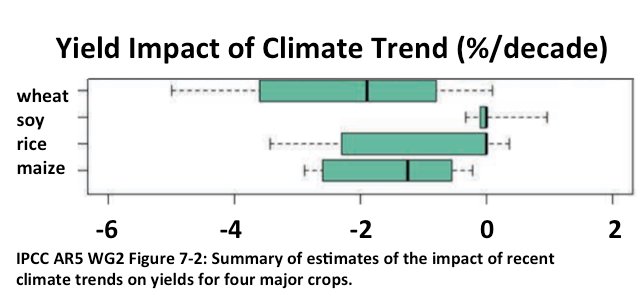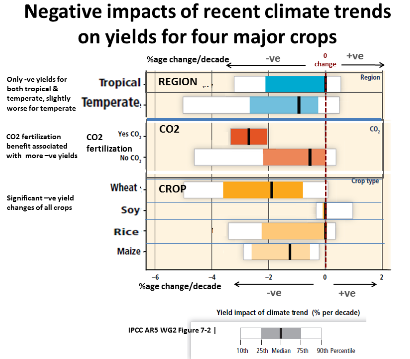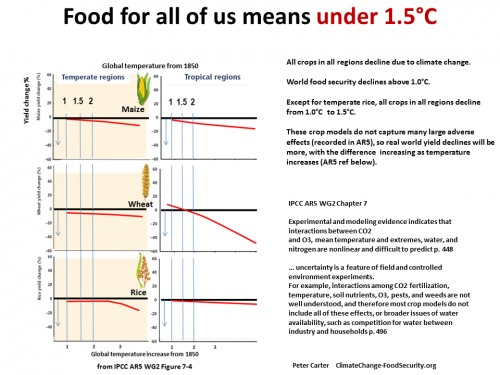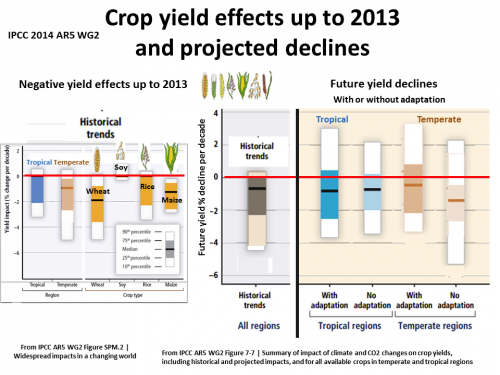Climate change and Food Security
IPCC 2014 5th assessment
IPCC 2014 5th assessment
ALL CROPS
IN ALL REGIONS
DECLINE
ABOVE 1.0C
INCREASING WITH
INCREASING TEMPERATURES
AND CLIMATE CHANGE
IPCC AR5
DECLINE
ABOVE 1.0C
INCREASING WITH
INCREASING TEMPERATURES
AND CLIMATE CHANGE
IPCC AR5

IPCC assessment and future food security
The IPCC results are very important to understand because it is only the IPCC assessment
that is recognized by policy makers and governments.
There are already observed changes top crop yields, which have all been negative for all regions.
The results for the future from computer model projections do not capture the extent of many large adverse impacts- including prolonged drought, heat waves, floods,pests ground level ozone and climate variability.
Crop diseases, weeds and pests have always been expected to increase under climate change.
They cannot project the effects of adverse impact combinations.
These model projections then are certainly what will happen at a minimum, but they do not tell us how fast and how bad the real world impacts will be.
5th assessment 2013-2014
The IPCC 2014 5th assessment on food reports more definite on declines of crop productivity at low levels of warming and climate climate, and on greater risks to the world's best food producing regions in the northern hemisphere.
The assessment assumes climate change adaptation will be successful in mitigating crop yield declines, but this is hard to believe when agriculture is no so highly developed today and the yield increases in the top NH food producing regions and the benefits of the 'green revolution' seem to be slowing and the AR5 reports yield declines in temperate regions already.
Certainly such an assumption on adaptation is not acceptable for risk assessment and risk response.
The big difference in the AR5 compared to previous assessments, is that the models no longer show a food production benefit for the Global North. The best NH food producing regions in the world will suffer crop declines.
For example North America
'Observed climate trends in North America include an increased occurrence of severe hot weather events over much of the USA, decreases in frost days, and increases in heavy precipitation over much of North America (high confidence).earlier peak flow of snow melt run-off and declines in the amount of water stored in spring snowpack in snow-dominated streams and areas of western USA and Canada (very high confidence).
Many climate stresses that carry risk—particularly related to severe heat, heavy precipitation, and declining snow pack—will increase in frequency and/or severity in North America in the next decades (very high confidence).
Global warming of approximately 2°C (above the pre-industrial baseline) is very likely to lead to more frequent extreme heat events and daily precipitation extremes over most
areas of North America, more frequent low-snow years, and shifts toward earlier snow-melt run-off over much of the western USA and Canada.Together with, more intense droughts, and increased precipitation variability, these changes are projected to lead to increased stresses to water, agriculture, economic activities'.(IPCC AR5 WG2 Ch26 Exec. Summary)
The IPCC results are very important to understand because it is only the IPCC assessment
that is recognized by policy makers and governments.
There are already observed changes top crop yields, which have all been negative for all regions.
The results for the future from computer model projections do not capture the extent of many large adverse impacts- including prolonged drought, heat waves, floods,pests ground level ozone and climate variability.
Crop diseases, weeds and pests have always been expected to increase under climate change.
They cannot project the effects of adverse impact combinations.
These model projections then are certainly what will happen at a minimum, but they do not tell us how fast and how bad the real world impacts will be.
5th assessment 2013-2014
The IPCC 2014 5th assessment on food reports more definite on declines of crop productivity at low levels of warming and climate climate, and on greater risks to the world's best food producing regions in the northern hemisphere.
The assessment assumes climate change adaptation will be successful in mitigating crop yield declines, but this is hard to believe when agriculture is no so highly developed today and the yield increases in the top NH food producing regions and the benefits of the 'green revolution' seem to be slowing and the AR5 reports yield declines in temperate regions already.
Certainly such an assumption on adaptation is not acceptable for risk assessment and risk response.
The big difference in the AR5 compared to previous assessments, is that the models no longer show a food production benefit for the Global North. The best NH food producing regions in the world will suffer crop declines.
For example North America
'Observed climate trends in North America include an increased occurrence of severe hot weather events over much of the USA, decreases in frost days, and increases in heavy precipitation over much of North America (high confidence).earlier peak flow of snow melt run-off and declines in the amount of water stored in spring snowpack in snow-dominated streams and areas of western USA and Canada (very high confidence).
Many climate stresses that carry risk—particularly related to severe heat, heavy precipitation, and declining snow pack—will increase in frequency and/or severity in North America in the next decades (very high confidence).
Global warming of approximately 2°C (above the pre-industrial baseline) is very likely to lead to more frequent extreme heat events and daily precipitation extremes over most
areas of North America, more frequent low-snow years, and shifts toward earlier snow-melt run-off over much of the western USA and Canada.Together with, more intense droughts, and increased precipitation variability, these changes are projected to lead to increased stresses to water, agriculture, economic activities'.(IPCC AR5 WG2 Ch26 Exec. Summary)

IPCC AR5 WG2 final science draft Ch. 7 Food Exec summary
The effects of climate change on crop and food production are evident in several regions of the world. Negative impacts of climate trends have been more common than positive ones.
Without (successful) adaptation, local/ global temperature increases in excess of about 1oC above pre-industrial is projected to have negative effects on yields for the major crops (wheat, rice and maize) in both tropical and temperate regions,
At 1.0C local and global warming are @ the same.- at higher degrees of warming local is higher than global warming.
Without (successful) adaptation, negative impacts on average yields become likely from the 2030s with median yield impacts of 0 to -2% per decade projected for the rest of the century and after 2050 the risk of more severe impacts increases.
These impacts will occur in the context of rising crop demand, which is projected to increase by about 14% per decade until 2050.
Studies have documented a large negative sensitivity of crop yields to extreme daytime temperatures around 30°C. These sensitivities have been identified for several crops and regions and exist throughout the growing season (high confidence). Several studies report that temperature trends are important for determining both past and future impacts of climate change on crop yields at sub-continental to global scales.
Evidence since AR4 confirms the stimulatory effects of CO2 in most cases and the damaging effects of elevated tropospheric ozone on crop yields (high confidence). Experimental and modelling evidence indicate that interactions between CO2 and ozone, mean temperature, extremes, water and nitrogen are non-linear and difficult to predict.
Changes in climate and CO2 concentration will enhance the distribution and increase the competiveness of agronomically important and invasive weeds.
Rising CO2 may reduce the effectiveness of some herbicides.
The effects of climate change on disease pressure on food crops is uncertain,
All aspects of food security are potentially affected by climate change, including food access, utilization, and price stability.
Nutritional quality of food and fodder, including protein and micronutrients, is negatively affected by elevated CO2,
Climate change will increase progressively the inter-annual variability of crop yields in many regions.
Regional chapters show crop production to be consistently and negatively affected by climate change in the future in low latitude countries, while climate change may have positive or negative effects in northern latitudes. NOTE The AR5 crop models show no increase in any yields anywhere without assumed successful adaptation.
Under scenarios of high levels of warming, leading to local mean temperature increases of 3-4C (global 2C - 2.7C) or higher, models based on current agricultural systems suggest large negative impacts on agricultural productivity and substantial risks to global food production and security. Such risks will be greatest for tropical countries, given the larger impacts in these regions, which are beyond projected adaptive capacity, and higher poverty rates compared to temperate regions.
Climate trends are affecting the abundance and distribution of harvested aquatic species, both freshwater and marine, and aquaculture production systems in different parts of the world. These are expected to continue with negative impacts on nutrition and food security for especially vulnerable people, particularly in some tropical developing countries, but with benefits in other regions which become more favourable for aquatic food production.
Increases in weather extremes
There is no consistent definition in the scientific literature of what constitutes
an extreme climatic event, and this complicates comparative global assessments.(AR5 WG1 FAQ 2.2)
All weather extremes are being increased by global climate change and are most damaging to crops,but are not captured by the crop yield projection models.
'Increases in the frequency or intensity of ecosystem disturbances such as droughts, wind storms, fires, and pest outbreaks have been detected in many parts of the world and in some cases are attributed to climate change' (AR5 WG2 TS)
'According to regional observations, most droughts and extreme rainfall events of the 1990s and 2000s have been the worst since the 1950s (Arndt et al., 2010), and certain trends in total and extreme precipitation amounts are observed'. (AR5 WG2 3.2.2)
Heatwave frequency has increased during this period (since 1950) in large parts of Europe, Asia and Australia.(IPCC AR5 WG1 Ch2. Extreme Events).
Hottest days have increased globally shows that and regionally most in: Western N. America, Western Europe,S. Mediterranean, N and West China, Mongolia, and S.E Australia. (AR5 WG1 Box 2.4, Figure 1).
Anthropogenic forcing has contributed to the observed changes in the frequency and intensity of daily temperature extremes on the global scale since the mid-20th century. Attribution of changes in temperature extremes to anthropogenic influence is robustly seen in independent analyses using different methods and different data sets.
It is likely that human influence has substantially increased the probability of occurrence of heatwaves in some locations. (AR5 WG1 Ch 10 Climate Extremes)
Drought:
Since the 1950s some regions of the world have experienced more intense and longer droughts (AR5 WG1 2.6.2.3).
Drought has increased in the Mediterranean and West Africa since 1950
For China from 1950 to 2006 longer, more severe, and more frequent soil moisture droughts have been experienced over 37% of the land area. (AR5 WG2 3.2.2)
A measure of sc-PDSI with potential evapotranspiration shows an increase
in the percentage of land area in drought since 1950. Van der Schrier et al. (2013) also finds a slight increase in the percentage of land area in severe drought using the same measure. (AR5 WG1 2.2.3)
Stream flow decreasing trends in low and mid-latitudes are consistent with recent drying and warming in West Africa,southern Europe,south and east Asia, eastern Australia,western Canada and the USA, and northern South America. (AR5 WG2 3.2.2).
Giorgi et al. (2011) indicate that ‘hydroclimatic intensity’, a measure which combines both dry spell length and precipitation intensity, has increased over the latter part of the 20th century in response to a warming climate. They show that positive trends (reflecting an increase in the length of drought and/or extreme precipitation events) are most marked in Europe, India, parts of South America and East Asia (AR5 WG1 2.6.2.3).
Future model projections project regional decreases in precipitation and in soil moisture.
Heavy precipitation events,
Anthropogenic forcing has contributed to a global-scale intensification of heavy precipitation over the second half of the 20th century. (AR5 Ch10. Climate Extremes)
Since about 1950, over land have increased in more regions than it has decreased. In North America and Europe there have been increases in either the frequency or intensity of heavy precipitation.(IPCC AR5 WG1 Ch2. Extreme Events).
Tropical cyclones of the N. Atlantic have increased in frequency and intensity of the and strongest tropical cyclones in the North Atlantic have increased since the 1970s (IPCC AR5 WG1 Ch2. Extreme Events).
AR5 WG2 Ch 7 Food
Tropospheric ozone
Evidence since AR4 confirms the ...damaging effects of elevated tropospheric ozone (O3) on crop yields (high confidence).
Changes in climate and CO2 concentration will enhance the distribution and increase the competitiveness of agronomically important and invasive weeds
(Exec Sum)
Tropospheric ozone
Emissions of CO2 often are accompanied by ozone (O3) precursors that have driven a rise in tropospheric O3 that harms crop yields Elevated O3 since preindustrial times has very likely suppressed global production of major crops compared to what they would have been without O3 increases, with estimated losses of roughly 10% for wheat and soybean and 3 to 5% for maize and rice. Impacts are most
severe over India and China , but are also evident for soybean and maize in the USA
(p.493)
The effects of climate change on crop and food production are evident in several regions of the world. Negative impacts of climate trends have been more common than positive ones.
Without (successful) adaptation, local/ global temperature increases in excess of about 1oC above pre-industrial is projected to have negative effects on yields for the major crops (wheat, rice and maize) in both tropical and temperate regions,
At 1.0C local and global warming are @ the same.- at higher degrees of warming local is higher than global warming.
Without (successful) adaptation, negative impacts on average yields become likely from the 2030s with median yield impacts of 0 to -2% per decade projected for the rest of the century and after 2050 the risk of more severe impacts increases.
These impacts will occur in the context of rising crop demand, which is projected to increase by about 14% per decade until 2050.
Studies have documented a large negative sensitivity of crop yields to extreme daytime temperatures around 30°C. These sensitivities have been identified for several crops and regions and exist throughout the growing season (high confidence). Several studies report that temperature trends are important for determining both past and future impacts of climate change on crop yields at sub-continental to global scales.
Evidence since AR4 confirms the stimulatory effects of CO2 in most cases and the damaging effects of elevated tropospheric ozone on crop yields (high confidence). Experimental and modelling evidence indicate that interactions between CO2 and ozone, mean temperature, extremes, water and nitrogen are non-linear and difficult to predict.
Changes in climate and CO2 concentration will enhance the distribution and increase the competiveness of agronomically important and invasive weeds.
Rising CO2 may reduce the effectiveness of some herbicides.
The effects of climate change on disease pressure on food crops is uncertain,
All aspects of food security are potentially affected by climate change, including food access, utilization, and price stability.
Nutritional quality of food and fodder, including protein and micronutrients, is negatively affected by elevated CO2,
Climate change will increase progressively the inter-annual variability of crop yields in many regions.
Regional chapters show crop production to be consistently and negatively affected by climate change in the future in low latitude countries, while climate change may have positive or negative effects in northern latitudes. NOTE The AR5 crop models show no increase in any yields anywhere without assumed successful adaptation.
Under scenarios of high levels of warming, leading to local mean temperature increases of 3-4C (global 2C - 2.7C) or higher, models based on current agricultural systems suggest large negative impacts on agricultural productivity and substantial risks to global food production and security. Such risks will be greatest for tropical countries, given the larger impacts in these regions, which are beyond projected adaptive capacity, and higher poverty rates compared to temperate regions.
Climate trends are affecting the abundance and distribution of harvested aquatic species, both freshwater and marine, and aquaculture production systems in different parts of the world. These are expected to continue with negative impacts on nutrition and food security for especially vulnerable people, particularly in some tropical developing countries, but with benefits in other regions which become more favourable for aquatic food production.
Increases in weather extremes
There is no consistent definition in the scientific literature of what constitutes
an extreme climatic event, and this complicates comparative global assessments.(AR5 WG1 FAQ 2.2)
All weather extremes are being increased by global climate change and are most damaging to crops,but are not captured by the crop yield projection models.
'Increases in the frequency or intensity of ecosystem disturbances such as droughts, wind storms, fires, and pest outbreaks have been detected in many parts of the world and in some cases are attributed to climate change' (AR5 WG2 TS)
'According to regional observations, most droughts and extreme rainfall events of the 1990s and 2000s have been the worst since the 1950s (Arndt et al., 2010), and certain trends in total and extreme precipitation amounts are observed'. (AR5 WG2 3.2.2)
Heatwave frequency has increased during this period (since 1950) in large parts of Europe, Asia and Australia.(IPCC AR5 WG1 Ch2. Extreme Events).
Hottest days have increased globally shows that and regionally most in: Western N. America, Western Europe,S. Mediterranean, N and West China, Mongolia, and S.E Australia. (AR5 WG1 Box 2.4, Figure 1).
Anthropogenic forcing has contributed to the observed changes in the frequency and intensity of daily temperature extremes on the global scale since the mid-20th century. Attribution of changes in temperature extremes to anthropogenic influence is robustly seen in independent analyses using different methods and different data sets.
It is likely that human influence has substantially increased the probability of occurrence of heatwaves in some locations. (AR5 WG1 Ch 10 Climate Extremes)
Drought:
Since the 1950s some regions of the world have experienced more intense and longer droughts (AR5 WG1 2.6.2.3).
Drought has increased in the Mediterranean and West Africa since 1950
For China from 1950 to 2006 longer, more severe, and more frequent soil moisture droughts have been experienced over 37% of the land area. (AR5 WG2 3.2.2)
A measure of sc-PDSI with potential evapotranspiration shows an increase
in the percentage of land area in drought since 1950. Van der Schrier et al. (2013) also finds a slight increase in the percentage of land area in severe drought using the same measure. (AR5 WG1 2.2.3)
Stream flow decreasing trends in low and mid-latitudes are consistent with recent drying and warming in West Africa,southern Europe,south and east Asia, eastern Australia,western Canada and the USA, and northern South America. (AR5 WG2 3.2.2).
Giorgi et al. (2011) indicate that ‘hydroclimatic intensity’, a measure which combines both dry spell length and precipitation intensity, has increased over the latter part of the 20th century in response to a warming climate. They show that positive trends (reflecting an increase in the length of drought and/or extreme precipitation events) are most marked in Europe, India, parts of South America and East Asia (AR5 WG1 2.6.2.3).
Future model projections project regional decreases in precipitation and in soil moisture.
Heavy precipitation events,
Anthropogenic forcing has contributed to a global-scale intensification of heavy precipitation over the second half of the 20th century. (AR5 Ch10. Climate Extremes)
Since about 1950, over land have increased in more regions than it has decreased. In North America and Europe there have been increases in either the frequency or intensity of heavy precipitation.(IPCC AR5 WG1 Ch2. Extreme Events).
Tropical cyclones of the N. Atlantic have increased in frequency and intensity of the and strongest tropical cyclones in the North Atlantic have increased since the 1970s (IPCC AR5 WG1 Ch2. Extreme Events).
AR5 WG2 Ch 7 Food
Tropospheric ozone
Evidence since AR4 confirms the ...damaging effects of elevated tropospheric ozone (O3) on crop yields (high confidence).
Changes in climate and CO2 concentration will enhance the distribution and increase the competitiveness of agronomically important and invasive weeds
(Exec Sum)
Tropospheric ozone
Emissions of CO2 often are accompanied by ozone (O3) precursors that have driven a rise in tropospheric O3 that harms crop yields Elevated O3 since preindustrial times has very likely suppressed global production of major crops compared to what they would have been without O3 increases, with estimated losses of roughly 10% for wheat and soybean and 3 to 5% for maize and rice. Impacts are most
severe over India and China , but are also evident for soybean and maize in the USA
(p.493)
Negative impacts of climate change on crop and terrestrial food production have been more common than positive impacts, which are evident in some high-latitude regions (high confidence).
Without (successful) adaptation, local (/global which is the same) temperature increases of 1C or more above preindustrial levels are projected to negatively impact yields for the major crops in tropical and temperate regions WG2 TS P. 10,22
Without (successful) adaptation, local (/global which is the same) temperature increases of 1C or more above preindustrial levels are projected to negatively impact yields for the major crops in tropical and temperate regions WG2 TS P. 10,22





Deficient crop models
IPCC AR5 WG2
7.6. Research and Data Gaps
The projections of crop yield changes rely on models that still do not capture many large adverse effects of global warming and climate change.
Many studies either do not examine yield variability or do not report it. We expect environmental thresholds
and tipping points, such as high temperatures, droughts, and floods, to become more important in the future.
Important gaps in knowledge continue to be studies of
weeds, pests, and diseases, including animal diseases, in response to climate change.
Yield and other agronomic
data, at a range of spatial scales, are crucial to the development evaluation, and improvement of models. Model development is currently limited by lack of data.
IPCC AR5 WG2
7.6. Research and Data Gaps
The projections of crop yield changes rely on models that still do not capture many large adverse effects of global warming and climate change.
Many studies either do not examine yield variability or do not report it. We expect environmental thresholds
and tipping points, such as high temperatures, droughts, and floods, to become more important in the future.
Important gaps in knowledge continue to be studies of
weeds, pests, and diseases, including animal diseases, in response to climate change.
Yield and other agronomic
data, at a range of spatial scales, are crucial to the development evaluation, and improvement of models. Model development is currently limited by lack of data.


IPCC AR5 data and projections shows the world is now (2016) committed (condemned) to food production decline, and affecting all main food producing regions.
IPCC AR5 2014 WG 2 Food Ch 7
WG2 Ch 7 Final science report. 'Without adaptation, local temperature increases in excess of about 1oC above pre-industrial is projected to have negative effects on yields for the major crops (wheat, rice and maize) in both tropical and temperate regions'.
With or without adaptation, negative impacts on average yields become likely from the 2030s with median yield impacts of 0 to -2% per decade projected for the rest of the century [also WG2 Table 7.3], and after 2050 the risk of more severe impacts increases (medium confidence). [Figure 7-5] These impacts will occur in the context of rising crop demand, which is projected to increase by about 14% per decade until 2050. [Figure 7-7] Regional chapters 22 (Africa), 23 (Europe), 24 (Asia), 27 (Central and South America) and Box 7-1 show crop production to be consistently and negatively affected by climate change in the future in low latitude countries
Note 2030 climate change is locked in due to climate system inertia.
Adaptation will be applied but cannot be assumed to be successful under a rapidly changing climate and increasing weather extremes.
IPCC AR5 2014 WG 2 Food Ch 7
WG2 Ch 7 Final science report. 'Without adaptation, local temperature increases in excess of about 1oC above pre-industrial is projected to have negative effects on yields for the major crops (wheat, rice and maize) in both tropical and temperate regions'.
With or without adaptation, negative impacts on average yields become likely from the 2030s with median yield impacts of 0 to -2% per decade projected for the rest of the century [also WG2 Table 7.3], and after 2050 the risk of more severe impacts increases (medium confidence). [Figure 7-5] These impacts will occur in the context of rising crop demand, which is projected to increase by about 14% per decade until 2050. [Figure 7-7] Regional chapters 22 (Africa), 23 (Europe), 24 (Asia), 27 (Central and South America) and Box 7-1 show crop production to be consistently and negatively affected by climate change in the future in low latitude countries
Note 2030 climate change is locked in due to climate system inertia.
Adaptation will be applied but cannot be assumed to be successful under a rapidly changing climate and increasing weather extremes.
